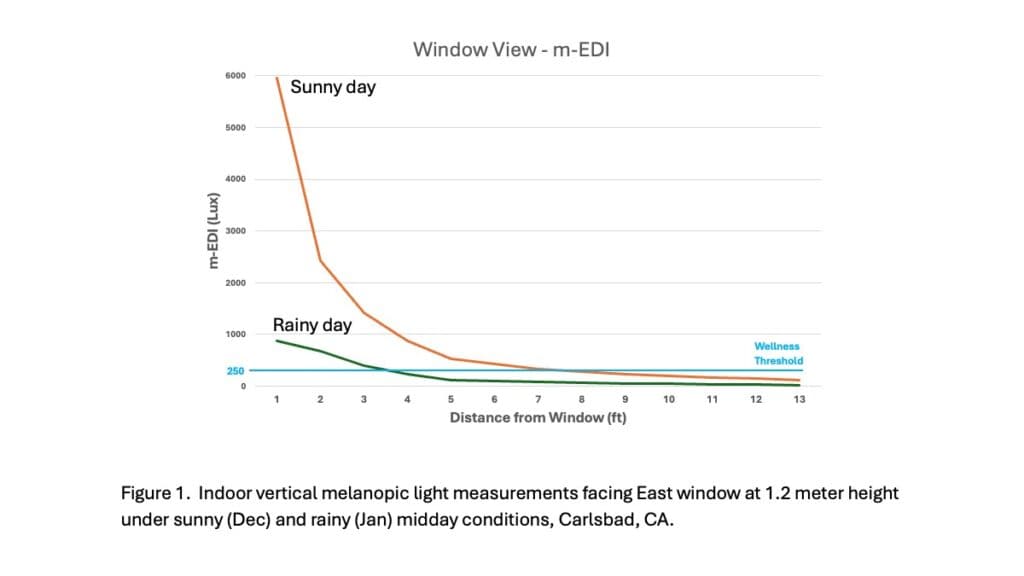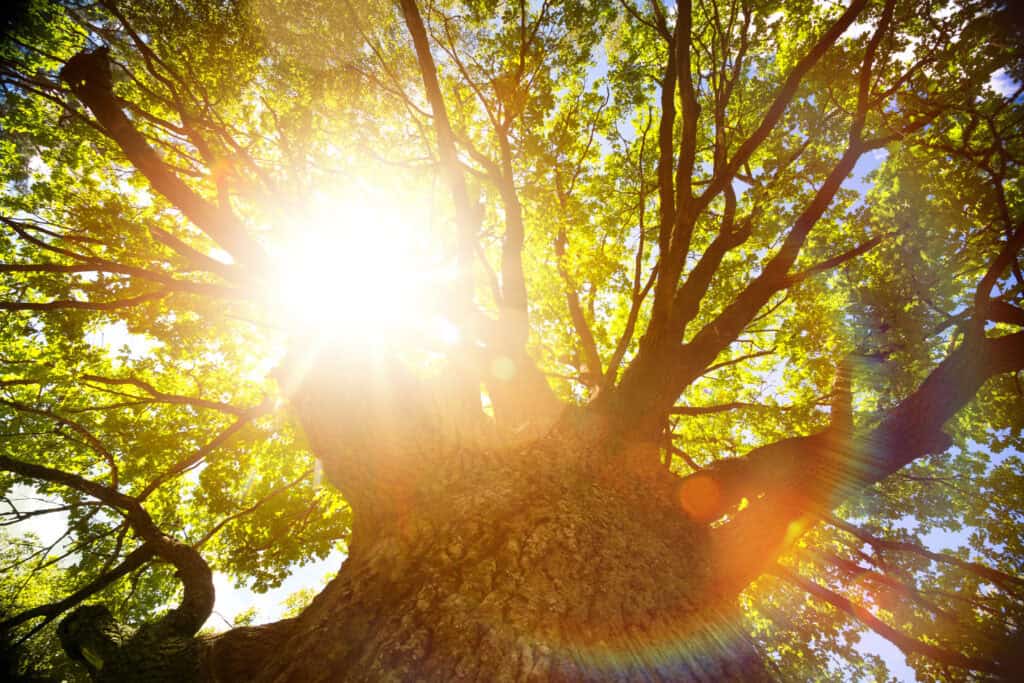As I put down the book to take a break from the bleak, stormy moors and constant gloom surrounding Wuthering Heights, the steady downpour outside my window accentuates my blah feelings on an otherwise relaxing winter weekend. I’m struck by the decidedly muted light bathing my reading chair, despite it being midday in Spring, and sitting within a meter of a large, east-facing window. I wondered how much mood- and energy-boosting natural light actually reaches me through the window during inclement weather. My handy melanopic spectrometer, held vertically facing the window at 1.5m, registered a mere 155 m-EDI despite being bright enough to read by. Could my present funk be part Brontë and part melanopic light deficiency?
Impact of Rainy Weather on Indoor Melanopic Light Levels
While it might seem obvious that cloudy conditions might block sunlight, be aware that the melanopic light in inclement weather is still typically thousands of times higher than indoors, even near windows. Research shows that rainy and overcast weather significantly diminishes both photopic illuminance (lux) and melanopic equivalent daylight illuminance (m-EDI, lux) indoors, particularly in spaces relying on natural light through windows. Indeed, overcast or rainy conditions combined with seasonal and latitudinal effects can easily reduce indoor melanopic EDI levels well below recommended thresholds (>250 m-EDI; Brown et al. 2022).
For instance, research in nursing home environments indicated that during winter, median melanopic EDI levels were as low as 57 lux, compared to 112 lux in summer for inward-facing measurements. (Kolberg et al. 2022). Even at the brightest times only 6 of 15 sites made the threshold m-EDI. Favero et al. (2023) found that although they could achieve sufficient melanopic light between 9:00 and 15:00 hours in winter overcast conditions, the levels varied significantly based on window architecture and viewer position. This suggests that natural light through windows during overcast days may not provide sufficient melanopic EDI for optimal circadian stimulation.
A Window on Weather
Extensive field measurements and modelling suggest that the impact of melanopic light through windows may be significantly influenced by common factors, such as window orientation, glazing, viewer gaze, and position in the room (Hraška & Hartman, 2022). Weather, as an independent factor, acts somewhat like a neutral density filter, decreasing overall illumination but significantly increasing the importance of other windowlight factors (Figure 1).

Then, there’s the reduction due to reflectance/absorption through the window material. Nazari et al. (2023) measured light spectra through various glazing conditions. Comparing no glaze to clear glaze shows an estimated 30% drop in melanopic light.
So, in bright summer light, melanopic adequacy indoors is not a challenge if you are near enough to the window. Under inclement weather, the situation could change dramatically. Measured and estimated reductions in overall and melanopic illuminance can be significant especially when also combined with seasonal and/or latitudinal effects. For example, ratios of overcast/sunny conditions have been measured at 0.09 (Discussed in Ticleanu et al. 2025) for locations in Great Britain. In my window measurements, the ratio was closer to 0.22 in Southern California and fairly consistent regardless of distance from the window (Figure 2).

The Window for Melanopic Light Gets Smaller
Taken in combination, the path for melanopic light to reach the eye is more of an odyssey (Table 1). Each factor reduces the available melanopic light resulting in significant stretches of time that a building occupant will not receive adequate melanopic light, even in a relatively well window lit environment.
Table 1: Factors influencing melanopic light exposure
- Season
- Latitude
- Weather
- Window orientation
- Window size/treatment
- Glazing transmission
- Distance from window
- Gaze direction
- Age related spectral absorption through eye
- Exposure time
Most of these factors are well recognized in building design and electric lighting is specifically planned to counter these and provide adequate illumination at the task plane. The growing awareness that healthy melanopic light exposure is even more susceptible and less supported by conventional interior lighting has led to new industry research and guidance (RP-46-23).
Mitigating the Effects of Low Natural Light: Making blue-sky days indoors
To counteract the reduced natural light during rainy or overcast days, especially in winter, away from windows, etc. incorporating electric lighting that mimics the spectral qualities of blue-sky daylight can be beneficial. Although standard LED lighting is inadequate, there is now a solution.
SkyView™ Tile brings the benefits of a blue-sky day indoors with breakthrough circadian lighting technology. Using BIOS’s patented GCO™ (Gradient Circadian Optimization), it delivers biologically effective light to support alertness, mood, and productivity—without glare or excess energy use. Installed on a 10’x10’ grid, it provides 250 melanopic EDI at eye level, warm 3500K task lighting, and just 0.4 W/ft² energy demand. SkyView™ Tile meets RP-46 and WELL standards, enhances workplace well-being, and easily retrofits into standard 2×2 ceiling layouts—making circadian lighting practical, efficient, and human-centric for offices, schools, and shared spaces.
The Power of a Blue-Sky Day
At the end of Wuthering Heights, the narrator reflects on the stormy, unhealthy lives of Catherine and Heathcliff, and how nature ultimately has the power to soothe human conflict and suffering.
“I lingered round them, under that benign sky; watched the moths fluttering among the heath, and hare-bells; listened to the soft wind breathing through the grass; and wondered how any one could ever imagine unquiet slumbers for the sleepers in that quiet earth.”
As I sit by my SkyView™ lamp and watch the rain come down, I wonder if the ending would have been different if Wuthering Heights estate had circadian lighting.
References:
Brown TM, Brainard GC, Cajochen C, Czeisler CA, Hanifin JP, Lockley SW, Lucas RJ, Münch M, O’Hagan JB, Peirson SN, Price LL. Recommendations for daytime, evening, and nighttime indoor light exposure to best support physiology, sleep, and wakefulness in healthy adults. PLoS biology. 2022 Mar 17;20(3):e3001571.
Kolberg E, Pallesen S, Hjetland GJ, Nordhus IH, Thun E, Flo-Groeneboom E. Insufficient melanopic equivalent daylight illuminance in nursing home dementia units across seasons and gaze directions. Lighting Research & Technology. 2022 Apr;54(2):163-77.
Favero F, Lowden A, Bresin R, Ejhed J. Study of the effects of daylighting and artificial lighting at 59° latitude on mental states, behaviour and perception. Sustainability. 2023 Jan 7;15(2):1144.
Hraška J, Hartman P. Assessing photopic and melanopic daylighting performance of special glazing system: A full-scale experiments. Selected Scientific Papers-Journal of Civil Engineering. 2022 Dec;17(1):6.
Nazari M, Matusiak B, Stefani O. Utilising spectral lighting simulation technique for evaluating transmitted daylight through glazing: Exploring the non-visual effects and colour appearance. Heliyon. 2023 Oct 1;9(10).
Ticleanu C, Flores-Villa L, Littlefair P, Howlett G. Assessing melanopic equivalent daylight illuminance in office spaces using a simplified approach for predominantly cloudy climates. Lighting Research & Technology. 2025 Feb 24:14771535251317740.



